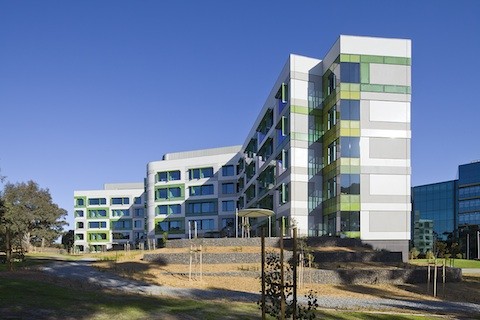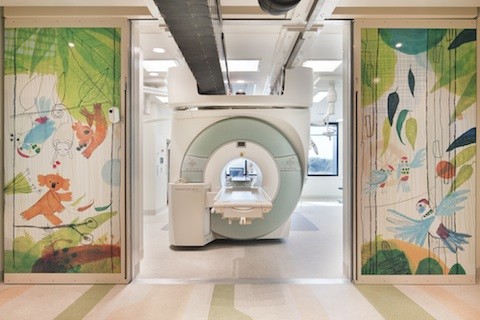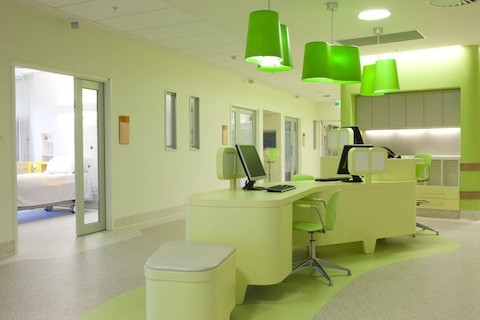Melbourne’s new $1b Royal Children’s Hospital (RCH), designed by joint venture Billard Leece Partnership and Bates Smart Architects (BLBS), with US based HKS as international advisers, incorporates a subtle collection of design features to create a restorative environment inspired by nature.
The construction of the new hospital has been managed by the Children’s Health Partnership with Lend Lease, based on ideas developed by the RCH and the Department of Health around a family-centred care model that puts children and their parents at the centre of the new facility.

BLBS turned to the hospital’s Royal Park location and the latest international research on the importance and value of nature in the healing process, to create the look, feel and effects that would characterise the building.
BLBS’ Design Director for the RCH project, Kristen Whittle, said the aim was to translate a child’s fascination with nature into an architectural language and let nature lead the design process.
“Our priorities were the creation of positive workplace settings for the clinicians, educators and researchers working at the hospital and of course, the family-friendly, child-focused, low-stress settings for those in need of care.”
The work of the USA’s Professor Roger Ulrich, looking at the impact of architecture on human behaviour, especially in hospital buildings, was also fundamental to the team’s thinking.

Project Description
More than 100 architects and designers were involved in creating the building based on the forms and colours mapped directly from the natural world to form an enriching and restorative environment for children, staff and the public.
The street concept and north orientation, allowed daylight-filled landscaped gardens around the full perimeter of the building, avoiding a ‘front and back’ portrayal. The natural slope of the site meant that the new facilities could link to the park at three different levels.
Landscape is omnipresent in the new structure. Everywhere from patient rooms to operating theatres you find views into courtyards or the park.
“The design of the wards is conceived as fingers reaching into the park — bedrooms all have a view of trees which reach up close to the windows. The interior is designed for maximum observation of patients but also provides good natural light to staff work areas. They don’t even need to turn on the lights,” explained Health Director Mark Mitchell.
At the heart of the new facility is the six storey ‘Main Street’ which links all the elements of the hospital together through a naturally lit public thoroughfare with expansive views of the parkland beyond.
A spectacular collection of child distractions are contained within the space including a two-storey aquarium, large-scale artworks, as well as a range of places to eat and meet with family, colleagues or friends. Melbourne Zoo, Scienceworks Museum and Hoyts provided installations within the hospital to distract and engage the imagination of all age groups.
It is also home to ‘Creature’, the 14 metre high sculpture by Melbourne artist Alexander Knox, and the Sky Garden mobile by Jade Oakley. Throughout the building, graphics by Melbourne illustrator, Jane Reiseger, depict landscapes and animals from around Victoria including inpatient units named after specific animals to further aid navigation.

The Inpatient Unit Building is designed in a star shape, connecting the rooms to the park. Specially designed, reflective glass sunshades on the hospital’s exterior allow activity in the grounds below to be viewed from the patient’s bed. One of the main features of the building is the sweep of coloured ‘leaf’ blades along Flemington Road, which have been fabricated from curved glass.
Masterplanning Director, Ron Billard says that, in terms of the architecture and the interior design, BLBS’s key priority was to deinstitutionalise the hospital experience.
“So, instead of having the waiting area look like a waiting area, we’ve tried to engender a sense of fun and discovery,” he explains. “For example, the seats are coloured, shaped and textured in an interesting way, they’re much more of a reference to creatures, to landscapes, to boulders and to gardens, so the seats don’t look like seats.
The new RCH also includes meditative gardens, staff break-out spaces, parking for 500 bicycles, an meerkat enclosure, water retaining and recycling technology and an abundance of artwork.


People
Client - The Royal Children’s Hospital
Architects — Billard Leece Partnership and Bates Smart (BLBS)
Masterplanning Director - Ron Billard
Design Director - Kristen Whittle
Health Directors - Sheree Proposch and Mark Mitchell
Interior Designer - Mark Healey
Artists - Alexander Knox, Jade Oakley, Jane Reiseger, Robert Ingpen
Images: BLBS

